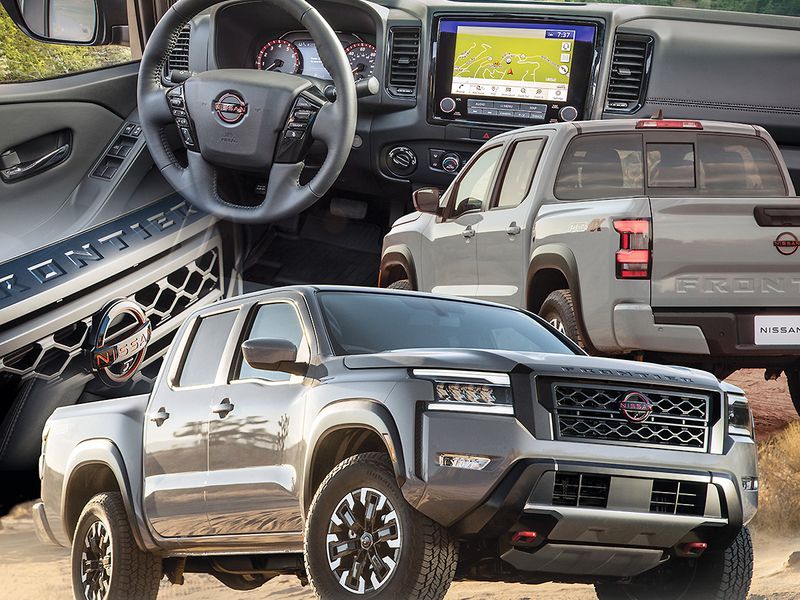
SUNDANCE, Utah — Nissan helped birth the smaller pickup segment in the U.S. in the 1970s and ’80s and doubled down on it with the introduction of the midsize Frontier in 1997.
But then an odd thing happened: Nissan allowed its bread-and-butter pickup to go from 2004 until now without a redesign.
During that time, Nissan’s Detroit competitors Ford and General Motors exited midsize pickups, and then returned, while Nissan watched its segment share shrivel from a peak of 29.3 percent in 2014 to 6.1 percent last year.
Nissan now wants back in the ring.
A new-generation Frontier, which arrives at dealerships in early September as a 2022 model, is ready to rumble, with larger proportions and a rugged design aimed at the heart of the lifestyle pickup segment.
Dealers are relieved to get a competitive pickup in the showroom.
“The Frontier has gotten long in the tooth, and people just buy them because of price,” said Wilson Sisk, president of Sisk Auto Mall in Hopkinsville, Ky. “Nissan helped build that market, and their direction is to go back and lead that market.”
That’s going to take work. Nissan has slipped to fifth place among midsize pickups, trailing the Toyota Tacoma, Ford Ranger, Jeep Gladiator and Chevrolet Colorado. Last year, the Frontier’s U.S. sales tallied 36,845, thanks largely to positive reliability ratings and a solid value proposition.
But the redesigned Frontier isn’t merely Nissan’s shot at relevance in midsize pickups — it is a rededication to pickups in general.
Nissan’s efforts to crack the full-size pickup market have made little progress. The Titan is dead last in that category, eking out a scant 1.5 percent share of the 1,161,563 full-size pickups sold this year through June.
“The full-size pickup market is mature and ultracompetitive,” Sisk said. “It’s a lot more attainable for Nissan to grab market share in the midsize truck market, which seems wide open.”
U.S. sales executive Judy Wheeler underscored the challenge with full-size pickups and offered a candid assessment of the Titan’s long-term prospects.
“It is very hard, I think, for a Japanese company to really do extremely well against the domestics,” Wheeler, Nissan division vice president of sales and regional operations in the U.S., said on the sidelines of a press event here.
Crossovers, sedans and midsize pickups are the “heart and the future for us,” Wheeler said. “If we can do Titan, we’ll continue to do Titan. But we’re not going to do crazy stuff.”
The outlook for the Titan is even more cloudy as Nissan turns to the need to bring electrification to its more competitive sedan and crossover segments. In addition to the Ariya electric crossover, which arrives next year, Nissan could bring another electric crossover to the U.S., built on the CMF-EV platform shared by partners Renault and Mitsubishi.
“Where do we want to spend the production and the investment for future product portfolio?” Wheeler said. “You’ve got to focus on what are your key core vehicles and not do this peanut butter approach.”
The redesigned Frontier comes at the tail end of a portfoliowide overhaul. The brand has redesigned key models, including the Rogue and Pathfinder crossovers and Sentra sedan.
“Nissan is skiing downhill and leaning forward right now,” Sisk said. “They are doing all the right things.”
With the Frontier update, Nissan delivers a more rugged design and capable powertrain.
The 2022 Frontier is a modern interpretation of the 1986 Nissan Hardbody. It features a larger grille, sits higher and looks more off-road than the current generation. The front end features a chiseled hood, framed by new interlocking headlights.
The rugged styling extends to the rear, with the taillights appearing to clamp to the body sides. The rear fenders combine with the bumper for an athletic stance.
The Frontier acknowledges an often unspoken desire of midsize pickup buyers.
“People like to talk about towing capacity and what it can do off-road,” Sisk said. “But the truth of the matter is 90 percent of people don’t take them off-road. They just want a good-looking truck to drive to Lowe’s and use as their daily driver.”
While the redesigned Frontier arrives with a conventional powertrain — a 3.8-liter direct-injection V-6 engine — future Nissan pickups could be battery-powered.
“I could see that coming,” Wheeler said of an electric powertrain. “The pickup area is kind of interesting. There will be a consumer that’s looking more for a lifestyle vehicle that they can put all their gear in and go off-roading.”
Wheeler noted Nissan’s early lead in the electric vehicle space with the launch of the Leaf hatchback more than a decade ago.
“We have this great base that we created with our consumers, our really strong dealer network that not only can sell [EVs], but also have a service network,” she said.
As Nissan gets back into the pickup competition, dealers are already lobbying for more — including a performance-targeted Nismo variant, given the potential high margins such a model would deliver. Some retailers believe that kind of off-roader could rekindle excitement in the brand and help attract younger, higher-income truck customers.
Nissan launched a similar model in the mid-2000s. That product was powered by a V-6 engine and sported off-road-tuned Bilstein performance shocks, skid plates, 16-inch aluminum-alloy wheels and an electronic locking rear differential.
In the past, Nissan has rolled out a Nismo performance package for the Sentra compact sedan, 370Z and GT-R sports cars and the Juke compact crossover.
But for the Frontier, the manufacturer is noncommittal for now.
Wheeler said she sees a market opportunity for a Nismo Frontier, but she said the possibility is only being researched at this time.
“You’ve got to come with the right features and offerings to make it work,” she said. “It can’t be like an afterthought.”

